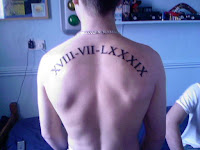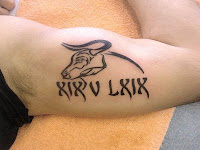Roman numerals are still used today (you'd know that if you would stay to the end of a movie). And they are numerals, not Roman numbers. If the Romans had used different numbers from what we use today, we would have the hell of a time converting them to our numeric system. Roman numbers, in fact, don't exist, scrap the term and start using Roman numerals correctly.
The system lent itself to abbreviation; eight could be shown as IIIIVIII but equally as VIII as the V implied the existence of four tallies before it. When transferred into writing, the identification of a single notch with I, the double notch with V, and the crossed out notch with X was an easy transition. The 50, though, was notched as a V with an additional notch down the middle. This was transferred into writing variously as an N, an inverted N, a K, the Greek letter psi or the inversion thereof, but the V with the I down the middle was common, too. By the time of Augustus, this latter writing had been flattened out to look like a T standing on its head. It didn't take too long for it to lose the foot bar to the left and become an L.
The writing for the higher numerals was also established by the Etruscans. The numeral for 100 resembled an inverted C tacked to an I attached in turn to a C. In time this was whittled down (excuse the pun) to the C as it coincided with centum (Latin 100). The sign for 1,000 was an X in a circle which evolved into several writing styles like an O with a notch down the middle, a laid down 8, a C tacked to an I attached in turn to an inverted C, an X bracketed by an I left and right, or a D with a pot belly to the left as well. The latter gave rise to the idea that the right hand half of the sign might have inspired the D for 500. The bracketed X in turn soon converted to an M in keeping with mille (Latin 1,000).
Tally sticks and early written numerals were additive. Pre-classical convention was that the highest numeral would start off the number represented and the lowest would end it (XXXXVIIII). The Etruscans introduced subtractive writing. A lower numeral would be written before the higher one to imply its subtraction from the following higher one. The Romans copied that convention like many other things and retained the Etruscan rule that only the decimal signs I, X, and C could be used in subtraction. Other rules for the use of these subtractions are not known to us if there were any. The Romans also used both the additive and the subtractive methods of writing numbers side by side. The Coliseum shows LIIII for entrance 54 for instance.
In the Middle Ages, the subtraction was used in and extended form to two numerals (as in XIIX for 18); this use has been discontinued, though. At the same time, they introduced the rule that the lower numeral should not be used before a numeral twice removed (i.e. IL and XM were not allowed). This rule is still commonly adhered to though it has been widely breached in the 20th century (e.g. the 49th division of the Wehrmacht was called IL and 1999 became MIM).
What it all runs down to is that the rules on the use of Roman numerals aren't set in stone and you better keep your eyes open to decipher all kinds of combinations. And when tattooing them onto your torso, make sure they add up. They are dastardly hard to remove.
Further reading
Writing Numbers
Is It All Greek to You?
Getting Translation Right






No comments:
Post a Comment